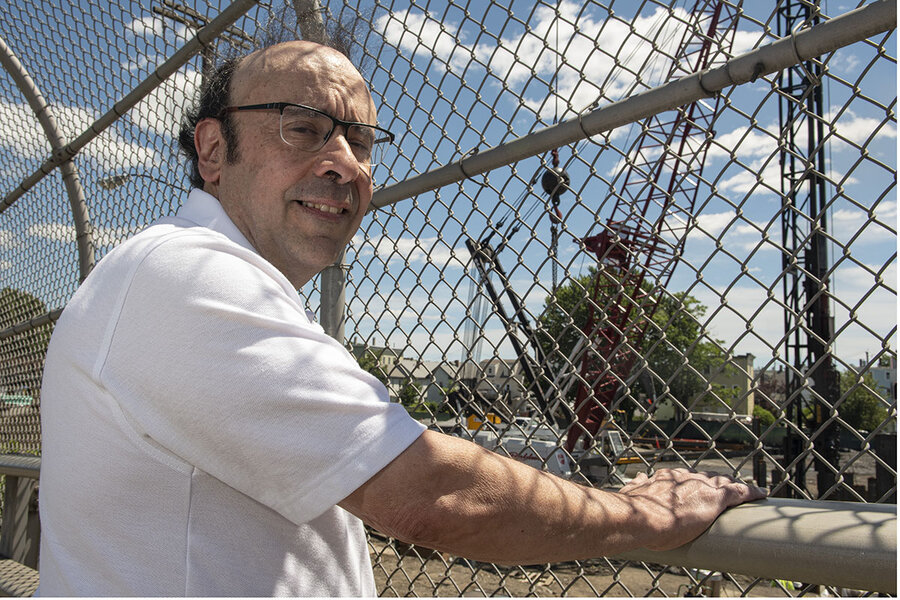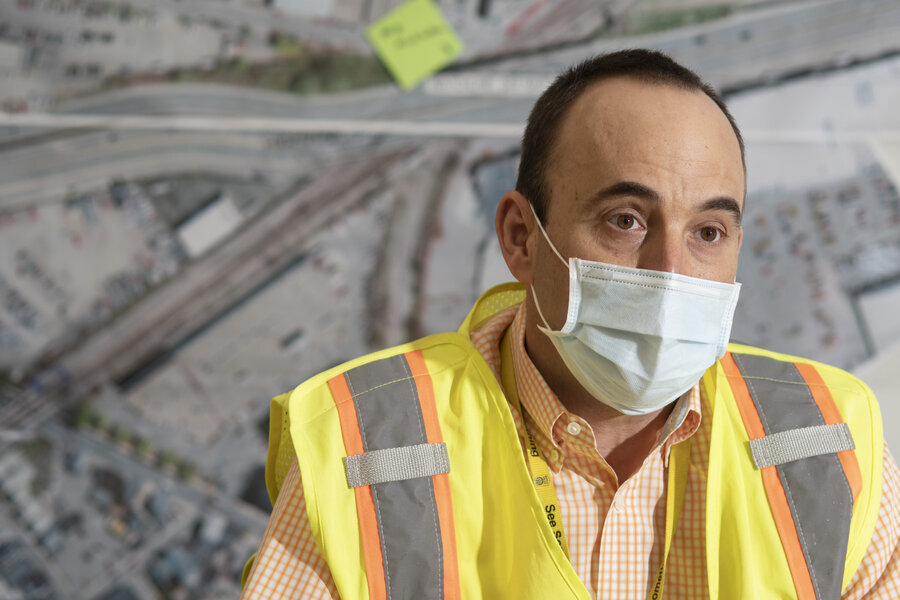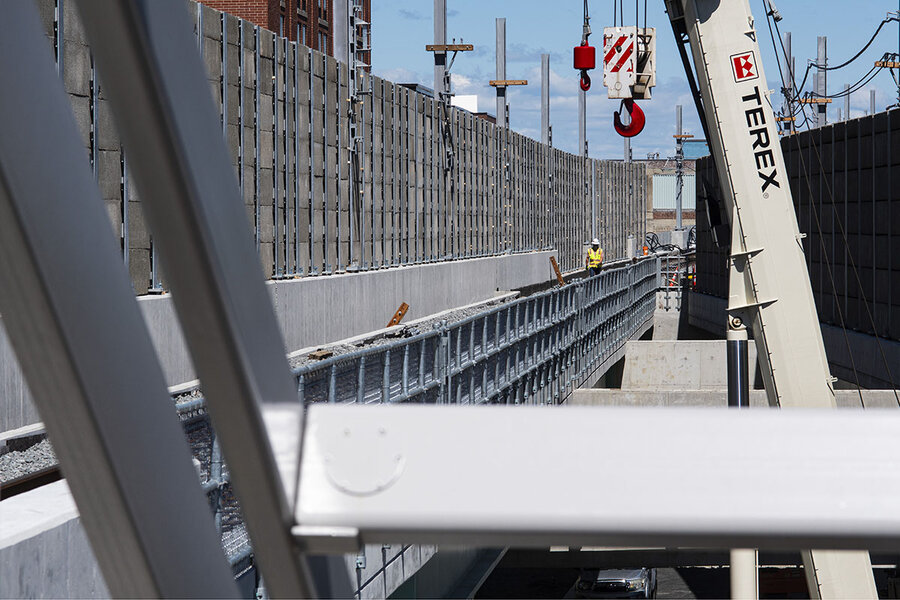Biden wants infrastructure. Does America know how to do it anymore?
Loading...
| SOMERVILLE, MASS.
In days gone by, America’s highways, bridges, tunnels, and dams were the envy of the industrialized world. Today, as President Joe Biden and lawmakers in Congress wrangle over a proposed $1.2 trillion bipartisan deal on infrastructure spending, tables have turned. The United States is better known for its maintenance backlog and for costs that far outstrip what other nations pay for projects that do roll forward.
Why? Consider the story of one rail-line expansion outside Boston. First proposed in the 1980s, this 5-mile stretch of above-ground track is set for a partial opening in December. Cost: more than $2 billion.
Why We Wrote This
How the U.S. rebuilds its roadways, airports, and rails is a major topic in Washington. A tale from a Boston suburb shows why America has fallen behind other nations – and what it needs to fix.
The challenges in Massachusetts mirror ones seen nationwide, from management shortcomings to stop-start funding and the risk of lawsuits. The project almost got canceled in 2015 as cost projections soared.
“We threw all the consultants out and started with a whole new team,” says Joseph Aiello, a former transportation official tapped to chair an independent review board.
To make the Boston-area project work, the new Union Square station in Somerville will be a bare-bones open-air stop with no plazas or elevators.
“This is what we were left with,” says William White, a city councilor and civil attorney. But “we’re getting the Green Line.”
From the bridge over the railroad, William White can trace the contours of the crowded city streets where he grew up, not far from the slaughterhouses and factories that abutted the tracks below. Those industries are long gone, and his working-class neighborhood is now a magnet for gourmet-doughnut browsing millennials.
More may be coming.
Below the bridge is a newly built station – construction still underway on the edges – that will link Somerville to Boston’s transit system, part of a long-promised extension. Private developers have already broken ground on an adjacent 25-story tower block aimed at biotech companies that cluster in nearby Cambridge. Dump trucks circle a dusty strip.
Why We Wrote This
How the U.S. rebuilds its roadways, airports, and rails is a major topic in Washington. A tale from a Boston suburb shows why America has fallen behind other nations – and what it needs to fix.
To Mr. White, a city councilor and civil attorney, the marvel is that the transit project is actually coming to fruition. He recalls how the troubled transit project was nearly scrapped in 2015 after massive cost overruns. To get it over the line, Somerville had to commit $50 million of its own money. Now service to this station on a spur line is due to start in December. “It all worked out. We’re getting the Green Line,” he says.
As President Joe Biden pushes for Congress to pass a new $1.2 trillion bipartisan deal on infrastructure spending, the odyssey of this project just outside Boston may serve as a cautionary example. Mr. Biden’s massive proposal addresses acknowledged needs that include railroads, highways, bridges, tunnels, and dams as well as mass transit. These American civic structures were once the envy of the industrialized world. Today the United States is better known for its dilapidated airports and crumbling bridges, and for political impasses in Washington over how to repair and update them.
A nationwide challenge
At a cost of $2.3 billion, the Green Line extension is more than twice as expensive as similar projects in Europe and Asia. And it’s not just Boston: Subway and light-rail projects in other U.S. cities also cost significantly more per mile. A 2015 review of projects planned or built in 44 countries found that four of the most expensive were in the U.S., led by New York City.
From Madrid and Paris to Istanbul and Seoul, politicians and engineers have figured out how to build subways and light rail faster and cheaper, giving their cities a competitive advantage in mobility and cutting auto emissions.
“We need to see a better return on investment,” says Eric Goldwyn, an assistant professor at New York University who studies transit construction costs.
Inflation also stalks U.S. highways, says Leah Brooks, an economist at George Washington University who studies urban economies. She found that the cost of interstate highways tripled between the 1960s and 1980s, a rise that wasn’t explained by higher labor or materials costs. Simply put, the U.S. gets less bang for its buck when it builds roads and bridges.
“Because it’s so expensive, we get so much less of them and we serve fewer people,” she says. “You’re spending $10 billion on a project that could have cost $5 billion.”
Analysts say inflated U.S. prices stem from multiple factors, including political interference and patronage and the stop-start funding of projects. Public agencies hollowed out by budget cuts fail to oversee contractors and end up with expensive errors. “Buy America” provisions complicate procurement. Lawsuits and reviews lead to delays, add-ons, and cost overruns.
First proposed in the 1980s, Boston’s 4.7-mile Green Line extension, known as GLX, endured many of these problems. It will also open at a time of pandemic-induced low ridership on U.S. transit systems, though Mr. White and other supporters voice confidence that riders will return.
Like other cities, Boston has other transportation projects that also depend on federal funding. Mr. Biden’s bipartisan plan would invest $49 billion in public transit and $66 billion in passenger rail. Whether that money is spent effectively is another matter, says Fred Salvucci, an engineer and former Massachusetts secretary of transportation. He urges local leaders to learn from how other countries build.
“My hope is that with the incentive of all this federal money, at least some states will say, ‘Let’s make the best use of it and use the best techniques we can,’” he says.
Boston has the country’s oldest subway line (1897). And it shows: An unwieldy network of trolleys and subways run by the Massachusetts Bay Transportation Authority (MBTA) has long struggled to keep pace with demand, even as rush-hour congestion snarls its narrow streets. Locals joke about whether to walk or take their time by taking the “T.”
Odyssey of an upgrade
The promise of extending service to new areas in Somerville and neighboring Medford originated in downtown Boston’s highway-and-tunnel boom of the 1990s, known as the Big Dig. It was the most expensive metro area highway project ever built. To offset the increase in car traffic and pollution, Massachusetts agreed to build the Green Line extension and other mass transit lines.
But the MBTA’s budget was later slashed as political support for transit projects fizzled, says Professor Salvucci, an engineer who helped plan the Big Dig. He notes that his boss, former Gov. Michael Dukakis, would ride the T to work and call him to report any delays.
“You need a chief executive who cares about this stuff and cares about getting it done well,” says Professor Salvucci, who now teaches at the Massachusetts Institute of Technology.
It took a series of environmental lawsuits to force Massachusetts to finally start work on the GLX. In 2014, Gov. Deval Patrick, a Democrat, secured a $996 million federal grant to extend the line, with the promise of the first stations to be operational within three years.
But the project’s costs had begun to balloon so much that it quickly unraveled.
Scaling back amenities?
Take Union Square, the neighborhood in Somerville where Mr. White grew up. Its station design was a two-level 15,000-square-foot structure with two elevators, bathrooms, ticket machines, and bicycle storage, with connecting ramps and outdoor seating. Price tag: $40 million.
For the community, it was a no-brainer, a T station as public amenity, says Professor Goldwyn. But a fancy station means less money for building tracks, so lines may end up serving fewer people. This is one reason, he notes, that New York’s Second Avenue subway that opened in 2017 at a cost of $4.5 billion – the world’s most expensive per mile – only has three stations.
“It’s perfectly acceptable to say this is a transit project – and a community building project,” Professor Goldwyn says of the GLX. But residents have to understand the trade-offs that come with station plazas and bike paths and other amenities. “That discussion needs to be had.”
Cracking down on cost overruns
In 2015, newly elected Gov. Charlie Baker ordered a top-to-bottom review of GLX after the MBTA put the final cost at $3 billion, not the $2 billion it had forecast. Governor Baker, a Republican, said the project was a non-starter at that price.
Expensive stations were symptomatic of a deeper cost problem, says Joseph Aiello, a former transportation official whom Governor Baker tapped to chair an independent review board. To Mr. Aiello, who had worked on private funding of public infrastructure, the budget blowout was a major management failure. “Someone wasn’t minding the shop,” he says.
By then, the MBTA had already spent nearly $700 million of public money on GLX, mostly on consultants. Due to cuts and retirement, the agency only had a handful of managers to oversee the project and used a complex bidding formula that favored contractors with an inside track.
“We threw all the consultants out and started with a whole new team,” says Mr. Aiello.
As a result, Union Square station is now a bare-bones open-air stop with no plazas or elevators. “This is what we were left with, so clearly we’re not going to say no,” says Mr. White, the city councilor.
Even after its redesign, the project wasn’t hitting its $2.3 billion budget, so Somerville was asked to pay into a contingency fund. Some residents objected to being “shaken down” for a state-led project, says Mr. White. But he saw the risk of cancellation as a death knell for commercial redevelopment and backed the mayor’s request for a $50 million bond issue. (Cambridge, where the line currently ends, put in $25 million.)
At the time, Governor Baker was prepared to kill GLX, says Professor Salvucci. “The only reason the Green Line finally got moving is that the mayor of Somerville wouldn’t give up.”
John Dalton, GLX’s project manager, who joined the MBTA in 2016, says support from the community has been essential during the main construction phase. In Somerville, the most densely populated city in New England, road bridges had to be rebuilt along commuter-rail lines where new tracks are being laid in parallel.
“We’ve closed major roads. We’ve been working around the clock. And we’ve been in people’s backyards, literally,” says Mr. Dalton.
Way behind global peers
While the GLX is an extreme case of budget overruns and delayed delivery, it is typical of how most U.S. transit is built, says Professor Goldwyn. The Green Line’s per-mile costs are only slightly less than Boston’s Red Line extension that ended in 1985 and was entirely underground. (Street-level rail is far cheaper than tunneling.)
Professor Goldwyn’s research team is studying GLX and similar projects in the U.S. and Europe to understand how American cities could build more cheaply, for example by rethinking project design and management. “We want to see a better return on investment,” he says.
Professor Salvucci says greater federal oversight of transportation projects might help contain costs and promote best practices, though he cautions that lawmakers will resist such strictures.
International transit cost comparisons are complicated by variations in design, scope, and terrain. But researchers find that most fall within a range and that U.S. transit costs are much higher.
And what seems indisputable is how much longer it takes to build U.S. transit. In the late 1990s, Madrid built and opened 35 miles of metro lines, mostly underground. More recently, Istanbul tunneled a 12-mile line with 16 stations between 2011 and 2018. Over a similar period, Seattle built a downtown light-rail tunnel with two stations. Its length? Just over 3 miles.
The costs of litigiousness
One common obstacle for U.S. rail and highway builders is litigation, or the threat of it, particularly when landowners or politicians decide to stop or divert a project. Professor Brooks says “citizen voice,” whether grassroots organizing or an affluent sense of “not in my backyard,” took off in the 1970s. That is also when road construction costs began soaring. While other countries also have robust environmental and social review processes, a final go-ahead for a project is conclusive.
Mr. Dalton, who has managed transit projects in Chicago and Dubai, says the U.S. legal and political context shapes how project costs are evaluated. “I think contractors here make a lot of assumptions about risk in terms of sort of community pressure and public pressure and political pressure that they know they are going to be subject to,” he says.
Still, providing avenues for judicial review is important, particularly given the history of U.S. highway building through minority communities, says Professor Brooks. And in the case of GLX, lawsuits kept the project alive by forcing Massachusetts to keep its commitment.
One proposal is to put a time limit on the environmental review of large projects. A bipartisan Senate road-funding bill released in May would impose a two-year limit on such reviews. This spending would be part of the president’s $1.2 trillion infrastructure plan.
Professor Brooks says Congress should also insist on transparency for federally funded transportation projects so the public can see where its money is spent. The Federal Highway Administration knows how much it provides to states. “But they can’t tie that money to specific projects so they literally cannot calculate” the cost per mile, she says. “That suggests a lack of political will.”
Back in Somerville, service on the main branch of GLX is due to start next May. And although the costs have gone up over the course of the project, Mr. Dalton says he’s confident that GLX will come in under the current budget – despite pandemic disruption and higher materials costs. The MBTA has told Somerville that it will get its $50 million back in full.












